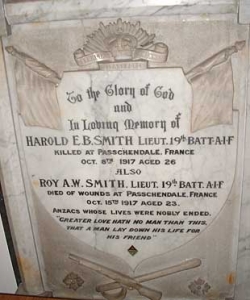Each Anzac Day I remember my two great Uncles, Roy Alfred Walter Smith and Harold Edward Benjamin Smith. They were sons of Frederick Edward William Smith and Mary Ann Seaton. I am a descendant of their sister, Eleanor Margaret (Nell) Smith. The smiths lived in Annandale in Sydney’s inner west.
H. E. B. Smith. Lieut., 19th Batt.

H.E.B. Smith. Photo from the All-Australia Memorial, 1917 (NSW Edition) and were supplied by Kim Phillips.
Harold was the older of the two brothers, born in 1891. He attended Annandale and Petersham Public Schools. He was a clerk before enlisting on 8 Mar 1915. He landed at Gallipoli in Aug 1915 and with the exception of a break of about three months (most of which time he was in hospital in Malta), was there till Evacuation. He went on to fight in France with the 19th Batt., wounded in 1916, after the Pozieres battle. On May 29, 197, he gained his commission after attending Officers’ Training School at Oxford. Harold was killed at Passchendaele, Oct 8, 1917. Red Cross records give the location as Zohnebeke or Broedseinde Ridge. His death was witnessed but there is no known grave site.
26 mar (1916 – Gallipoli) – standing bye ready to go ashore. March through Marseilles. People treat the boys with flowers and give us a good reception. Women tram conductors – no young men about. Most of people dressed in blacks. Marched to Railway station and left Marseilles at 9:30 pm. Fairly comfortable.
Harold’s Diary
“He was C.Co X Pltn in command. I saw him hit by a bullet in the groin as we were attacking outside Daisy Wood, Ypres sector, on the afternoon – daylight – of the 8th Octr 1917. I was in a shell hole and he was on the brink. He fell into the hole and was conscious. Capt. Taylor of D.Coy was also in the hole and spoke to Mr Smith. We advanced and dug in and held the ground. I saw Mr Smith carried back by German P/W and heard that he died of wounds on the way out.”
Witness account, Red Cross Records
R. A. W. Smith. Lieut. 19th Batt.
Roy was the younger of the two brothers. He attended Annandale, Petersham and Fort Street Schools. He was a surveyor’s assistant. Of the two brothers, he was first to enlist in 1914 as part of the Aust. Exp. Force to Rabaul. He re-enlisted on 1 March 1915 and was also attached to the 19th Batt. as Seargent. He landed at Gallipoli in Aug 1915 and was there till Evacuation. He went on to fight in France with the 19th Batt. and was invalided in June 1916. After his return to France he was engaged as an instructor at the “Bull Ring”. From there he was recalled to the 19th Batt. to take part in the Bapaume battle. He was granted his commission on the field on May 12, 1917. Roy was wounded at Passchendaele (Daisy Wood) Oct 8, 1817, the same day that Harold was killed. Roy died one week latest Oct 15, 1917.
24 oct (1916 – Gallipoli) – I still have my morning roll call of fleas and lice but I am afraid the class is getting too big for me to handle.
30 oct (1916 – Gallipoli) – my daily routine consists of:- 5 am wake all my platoon up to stand to arms ill 6 am breakfast about 7 am. During the morning get wood and water fatigues out and make parade state. Sometimes in the afternoon I take a fatigue party to the trenches for digging purposes. Stand to arms between 6 pm and 7 pm then turn in to sleep if the fleas will allow it.
Roy’s Diary
“He was wounded through the left arm severely also received a bullet through his left lung and spine. We were both in the same ward at No. 3 C.C.S. Poperinghe up [to] the time of his death. The sisters and doctor never gave him a chance of recovering as he was paralysed from the hips downwards. He suffered no pain whatever but gradually sank and died th seven days after admission…. He was admitted on the 10 October and died th on the 17 October”
Witness Account, Red Cross Records.
Reading both their diaries I feel a distant connection to their lives in Gallipoli and France. I feel for their mother, Mary Ann, who had to write constantly to learn of their fate. Research I have been doing just now shows that her father, James Seaton, was killed in a horse accident when she was a teenager. The Great War was a hard time from many Australian families. I am happy that we have our way of remembering them on Anzac Day each year.
References
When searching any of these references, it helps to use a service number. Harold’s service number for the AIF was 326. Roy’s service number for the NM&EF was 651, and for the AIF was 1304.
(1) Matthews W, Wilson D (2011) Fighting Nineteenth: History of the 19th Battalion, AIF, 1915-1918. ISBN 978-0-9807774-4-4. The book has an associated website at: http://19btn.wordpress.com/
(2) National Archives of Australia – Service Records, World War I (NameSearch)
http://www.naa.gov.au/collection/explore/defence/service-records/army-wwi.aspx
(3) Australian War Memorial Collection – First World War Diaries
http://cas.awm.gov.au/item/2DRL/0429 (Roy’s records)
http://cas.awm.gov.au/item/2DRL/0430 (Harold’s records)
(4) Australian War Memorial – First World War Red Cross Wounded and Missing
http://www.awm.gov.au/research/people/wounded_and_missing/
(5) Register of War Memorials in New South Wales
http://www.warmemorialsnsw.asn.au/details.cfm?MemNo=1889
(6) National Library of Australia – Trove
http://trove.nla.gov.au/
(7) Australian Government Department of Defence – Defence Honours & Awards
http://www.defence.gov.au/medals


